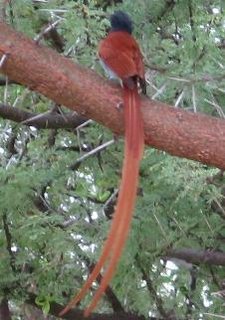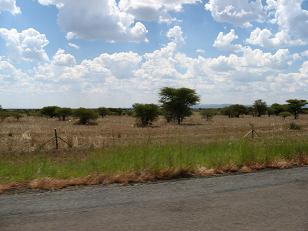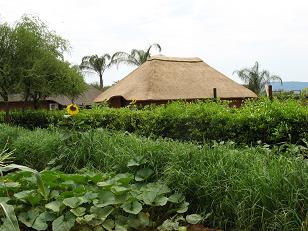Boa constrictors and biltong
There is a little bird the colour of flames outside my window. He isn’t much bigger than a sparrow, but he has two long tail-feathers that he uses as a rudder. He flits between the thorn trees, catching insects and flirting his tail at me, daring me to try to get a photo of him before he disappears.

One paradise flycatcher.
(Note the thorns in the tree.)
It’s early now, before 7am, and this is the coolest part of the day. By lunchtime, the sun will be intense and the humidity will make a sauna of the stoop (verandah) where I like to sit. It’s cooler this morning because a gusty change blew in yesterday afternoon, bringing wind and thunder but not much of the hoped-for rain. This is the rainy season, but it’s dry here, too.
We arrived here on Sunday afternoon, driving up from Johannesburg. We didn’t see much of the city because I landed late Saturday afternoon after 17 hours of plane travel and airport waits. I crashed and burned early.
The hotel had a pretty Mediterranean garden and a long pond that boiled with koi carp.

Next to the hotel was a place called Montecasino. It looked like an old European fort, but it was less than 10 years old. Walking through the front doors was like stepping into the Twilight Zone. Inside, they had recreated an Italian village, complete with two-storey stone-fronted buildings, cobbled roads and old cars parked in strategic spots.

The landscape here is surprisingly similar to the Australian landscape. Once you leave the city, the road is bounded by red dirt, a haze of tall grass and silvery trees. The sky is huge.

Look familiar?
Another big difference is that people walk for miles here. You see them in the middle of nowhere, carrying bags or boxes on their heads. They must have walked for 20km already and have another 10 in front of them before they will see anything but thorn trees and heat-hazed tarmac. Others have found rides in the back of utes, or bakkies, as they are called here. I saw two men sitting in the back of a bakkie, riding sidesaddle on the sides of the tray. The bakkie was spinning along a dirt road in front of a settlement and every time it hit a bump, the men would become airborne for a moment.
In the towns and cities, you also see people with roadside stalls selling the oddest collection of wares. Mirrors, for example, all tied to a chain wire fence. People wander among the cars stopped at traffic lights to sell things, too, anything from roses to headphones. If you see a sign with a man sitting next to a table piled with a pyramid of black oranges and a slash through the middle, it's a no street stall area.
We struck out on the N1 for Pietersburg – or Polokwane, depending on which road sign you see. A lot of town names were changed recently, but most people still use the old Afrikaans names and some of the signs are behind the times. Makhado used to be called Louis Trichardt and Pretoria, near Johannesburg, has become Tshwane. On the highway, we passed signs pointing to places with names like Tweefontein, Olifantfontein and Warmbaths.
Black settlements are dotted along the highway. They are a mix of government-built brick houses and tumbledown shacks made from patchworks of tin and wood. Often, both types of house have tin roofs held on with rocks, bits of wood and rusting metal. It’s as if the budget for some of the brick homes couldn’t stretch to roofing nails. The settlements are sad, depressing-looking places, surrounded by red dust. Children scuffle about in the dirt. Occasionally you see someone lying on an old mattress in front of a doorway.
As we drove, the landscape became hillier, with bouldery mountains that wouldn’t look out of place in the Northern Territory. I took photos through the windscreen because there was nowhere to stop and, anyway, stopping isn’t advisable.


Sorry, don't know what either of these are called.
That pointy one looks a bit like Tolkein's Lonely Mountain, though.
For this reason, we passed the Tropic of Capricorn doing 120. Apparently, it's a known Haunt of Bandits. (Don’t you love that expression? It could almost be a collective noun – a murder of crows, an unkindness of lawyers, a haunt of bandits.) They wait there for tourists who want to have their photo taken at the rock that marks the exact point of the tropic.
Everybody reminds you to be careful when driving. You're supposed to keep the doors locked, the windows up and never stop for hitchhikers or people with car trouble. I’m not sure whether this story is an urban myth, because I’ve heard it a couple of times with slightly different details, but it’s interesting in any case. A woman was driving down the highway when a man (yes, a black man) stepped out in front of the car, trying to flag her down. She was in a four-wheel drive, so she swerved around him, onto the rough at the side of the road, before driving to the nearest police station. The police went back to the spot, but the man was gone. When they looked in the long grass by the road, however, they found several corpses. The men had been lying out of sight, waiting to carjack her and instead she ran over them.
But we made it to Palm Have safe and sound. The lodge is owned by Richard and Angela Ball, a lovely, generous couple with two young daughters. Richard used to be a big game hunter and both he and Angela would lead hunting parties, looking for game. They’ve hacked out farms in Zambia with little more than hand tools and are incredibly hard-working and strong. Now they farm and run this lodge. They both speak Afrikaans, but identify themselves as “English”, meaning they have English heritage rather than Dutch.
The week before I arrived, Angela dragged a boa constrictor out of the duck pond that doubles as a swimming hole for the girls. It had already hoovered up a couple of pet rabbits and obviously thought the pond looked like a nice spot for some quiet digestion. The snake was 3m long and as thick as a thigh. None of the people who work on the farm would get near it. They believe that a large snake like that carries the spirit of someone who has died and must have been sent to harm them. Richard eventually came running and dealt with it.
The property really is beautiful. When you drive up the 2km driveway, there are ten foot electric fences on both sides, giving it a bit of a Jurassic Park feel. Inside the main compound are Richard and Angela's House, the vegetable gardens, fields and the lodge. Behind the lodge, there's a yard surrounded by fiery cannas and thorn trees. Beyond the yard, the goats and pigs wander in uncleared veldt. Every now and then, a rabble of rusty piglets rushes up to the wire fence before snuffling away again.

Bacon Sandwich, Ham Roll and Pork Chop
Beyond the veldt is the bony, blue spine of the mountains. Today it is frosted with low cloud left over from last night's thunder storm.

The view from the stoop
The vegetable gardens are surrounded by a hedge of pleached lemon trees. Almost everything grows in those gardens: sunflowers, garlic, herbs, eggplant, tomatoes, lettuce, capsicum, pumpkin, you name it. Chooks roam free. One of them likes to lay her eggs in the doghouse.

I’ve been adopted by Jorgi, a little grey and white cat who looks a lot like my Mr Furpants except for his whiter face. His father was a black-footed African wildcat, but Jorgi is quite tame and happy to sleep on my lap. He realised fairly quickly that I was a soft touch and now comes straight to me for bits of biltong at the bar. He’s a tough little bugger, though, and catches snakes when he can.
Bloke goes to work on the air force base during the day, leaving me to my own devices, but Richard and Angela have been keeping me busy. Yesterday, Richard's friend, Oom (Uncle) Jaco came around to show me how to make biltong. This is a South African favourite, the equivalent of a vegemite sandwich: it’s a spiced, dried meat, something like beef jerky, except edible.
Oom Jaco is a great bear of a man with a big heart, a fourth generation Capetonian “wine farmer” who has a rose nursery near Palm Haven. He also has a little bar and a general store that is known for having the best biltong in the area. He makes all his own biltong and drywoers, a sort of thin dried sausage. When he arrived, he was wearing faded khaki shorts and shirt and looked every bit the Afrikaaner farmer.
We went out to buy spices and meat from the abattoir and then settled in on Richard and Angela’s stoop to make the biltong. Oom Jaco started things off by putting a couple of handfuls of spice in the bottom of a big plastic tub and adding the first layer of meat and marinade. We were using beef, but game meat like kudu is good too. I think you can use any red meat but pork, which for some reason goes rancid instead of curing.
Then he handed over to me and I ended up with splatters of bloody meat juice halfway up my arms, slicing, spicing and packing about 25kg of beef. You have to leave it to marinate overnight and then you hang it from hooks in a dry, airy place for three days to cure. After that, you can freeze it or let it continue to dry. It’s usually shredded by a rotary slicer and served in thin slivers, though some people prefer to just carve off hunks with their knives.
Throughout most of the packing process, I had four dogs sitting hopefully at my feet and Richard, Angela, Oom Jaco and a neighbour looking on approvingly. I have a vague suspicion that this was at least partially a test to see whether I was a useless girly type who would say, “Euwwww! Meat! Blood! Do I have to touch it?” But that’s OK. I think I passed.
Richard brought me a baby boa constrictor yesterday, which I think was another little test. He'd fished it out of a flower bed. I held out my hand and to take it and he said, “Whoa! No!” Their bites fester, he said. It was a pretty little snake, though, about 18 inches long. It wrapped its body around my hand while Richard held it by the head and it made a good show of trying to squeeze my wrist. He dropped it tail-first into a water bottle with air holes punched in the top for Bloke to take to the base and release. They’re good ratcatchers, but not particularly welcome at a lodge. Plus, Jorgi would have found it sooner or later and done for it.
I have to admit that I was slightly turned off when Richard ate a live grasshopper at the dinner table the night before last. I found a big, dust-coloured locust sitting on the doorframe in the bathroom and brought it out with me, hoping it wasn’t the sort that spat acid. We’d finished eating, so I dropped it on the table.
We’d all had a few drinks by then (I’d been mixing mojitos at the bar) and Richard started talking about the types of grasshoppers that were good to eat. He picked it up and turned it over and said this sort wasn’t great eating. I expressed some doubt that it would be any good raw anyway, so he ate it in two bites, dropping the wings in the ashtray. He ended up with a leg stuck between his teeth, which I suppose is poetic justice.
Here endeth the first instalment.


13 Comments:
Brilliant....I felt like I was there. Glad I understood that Cheetahs and Hawks are fighter jets in the SAF otherwise I may have thought that cats could fly LOL. Can't wait for the next instalment. It is weird to think that you went thru the Trop of Cap as I live smack on the top of it :)
Thanks, that was a great read.
Hmmmm. Do we like Richard the English? Big game hunter, eh?
But I'm still BLOODY JEALOUS! It is my dream to go to Africa.
Scorpy, thanks matey. You're on the tropic, eh? Do you have a stone and a Haunt of Bandits out the front? ;)
Lucy, thanks! I'm glad you enjoyed it.
Meva, yes, we like Richard. He's a good bloke and he's not a hunter anymore. But you have to remember, this is Africa.
MUCH better than Catriona Rowntree's pathetic payola efforts. Next time I want to hear that YOU ate a bug. ;)
fascinating.
more stories!!
more pics!! specially of baby boa constrictors.
and more urban legends please.
thats some good readin!
Those biltongs sound rather delicious!! If I can find it here it might make a good next instalment of 'Incredible Inedibles'. :)
Keep those photos coming!
Just like a postcard only different. Lucky there wasnt any pork in the biltong---you may have counted one less little brown pig. Keep it coming---sounds like you are having a ball---cant wait for the first venture into the water in the new bathing outfit
Lonie, heh. Poor old Catriona ain't a hack, remember ;) I'm not sure I can come at live bugs, though. Fried, sure. Would have been all over it, but I don't like my food struggling.
Rach, I'll see what I can do. I've been told not to pick up anything slithery, because nine times out of 10, it's going to be a black mamba and you don't want to mess with those little suckers.
Pet, you may just get to try some when I make it. I'm under instructions to try it out on kangaroo when I get home.
Ted, I'm hoping not to have to get the togs out at all. So far I've been successful...
I haven't seen pointy mountains like that since the middle east. It was nice to see them again...
Great travel story red.
v.interesting stuff. Keep up the tales please.
Not sure I could live there. And eating locusts? eek.
I was racking my brains and finally Mr Google came the rescue.
Its Kipling: "The great grey-green greasy Limpopo river, all set about with fever trees".
Lovely story, thanks, keep them coming please.
You held out your hand to take the baby boa? Wow, I am impressed. Looking forward to the next instalment. And yes, nice urban myth indeed.
Post a Comment
<< Home